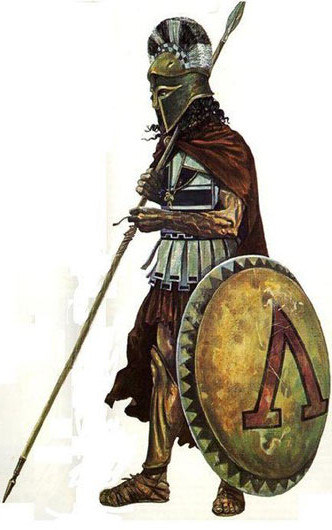The Spartan hoplite is seen here in full battle array. His Corinthian helmet is of brass and decorated with a transverse crest; his shield, with Spartan blazon, is brassfaced, as are the full-length “muscled” greaves. The white linen corslet, worn over a red tunic, replaced the heavy “bell” cuirass and was made from several layers of material glued together. The lower part was cut into strips to facilitate bending down. The corslet found favour because of its lightness but was often reinforced with plates. The red cloak seen in the illustration was the characteristic Spartan uniform. It was discarded in battle. Before the time of Alexander, beards were usually worn in Greece and long hair characterised Spartan adult men. Herodotus describes how the Spartans; awaiting the Persian onslaught at Thermopylae, passed their time in taking exercise and combing their hair. This hoplite is binding a leather handgrip around the shaft of his spear to enable him to obtain a firm purchase when thrusting it overarm over the wall of phalanx shields. Unlike other hoplites, the Spartan trained all his life as a soldier, and was thus a “professional”. His drill and weapons-skill were thus superior to, and more fearsome than, that of other hoplites.
Spartan’ Army Organisation
There are two fairly detailed but differing accounts of the organisation of the Spartan army. According to Thucydides, writing near 400 BC, the organisation was based on an average file of 8 men, 4 files making up an enomotia, or platoon, commanded by an enomotarch,’ four enomotiai comprising a pentekostys or company, and commanded by a pentekonter,’ and four pentekostyes making up a lochos, or battalion, and led by a lochagos. 7 lochoi comprised an army. Xenophon, who like Thucydides was an officer in the field and is therefore an equal authority, gives only two enomotiai as comprising a pentekostys, two pentekostyes making up a lochos and four lochoi a mora, or regiment, commanded by a polemarch. The army comprised six morae. Population decline later affected total strength, but that of the mora (variously reported as 500, 600 or 900) depended on the age groups called up. Theenomotiaimarched one behind the other in column. When deploying for battle, rear units formed up on the left of the leader so making a phalanx of four columns, sixteen abreast and eight deep, with two metres between columns. On the command to form closeorder the rear half of each enomotia would move up to fill the gap on each file’s left.
Other Troop Types
The foot soldier shown above was mostly of helot, or serf, stock and accompanied his master into battle. Armed with a javelin or alternatively a sling, he would also support his master with refreshment, carried in a goatskin bag. The trooper seen here carries a bunch of javelins, each one of which has a loop attached. The loop was twisted round the shaft and then around the first two fingers of the thrower, enabling him to impart greater leverage and spin to the weapon, thus increasing accuracy and range. The cavalryman, a Thessalian, wears unusual headgear, probably made from cowskin, and carries no shield. Like all ancient horsemen he lacks stirrups and sits well back to maintain control of his horse.
